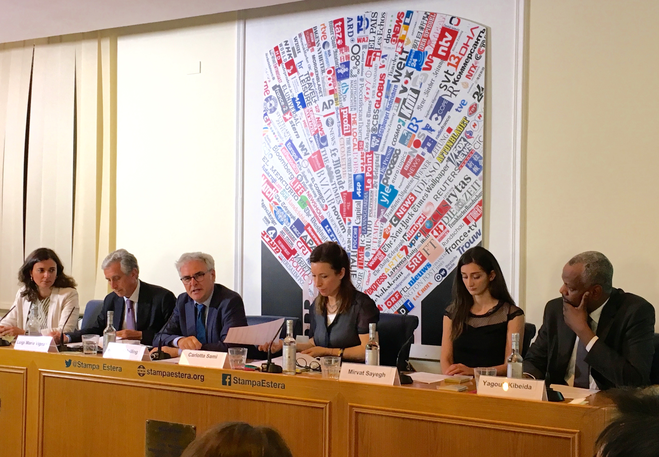


June 20 is World Refugee Day, honored this month with a series of diversified and imaginative events taking place throughout Italy. To begin with Rome, the city hosts an exhibition of photographs taken by 15 unaccompanied minors from Albania, Somalia, Ghana, Nigeria, Egypt, Eritrea, and the Philippines.
Also on offer in Rome, the presentation in a city park of the book "Superman too Was a Refugee," and at the MAXXI Museum [2] a showing of the National Geographic documentary film by famed photographer Massimo Sestini [3] called, "Where are you? Tell me where you are."
An 18-musician orchestra called the "Orchestra dei Braccianti e Nada" (Orchestra of the Field Workers and Nada") performs in concert at Rome's Villa Ada park. Like this one, many of these events are star-studded: San Remo Festival viewers will recall Nada [4]'s 1971 victory there with the pop song "Il Cuore è uno Zingaro" (The heart is a gypsy). Besides an Italian musician, the 17 others in the cosmopolitan orchestra are from the U.S., France, Gambia, Ghana, Nigeria, Libya, Tunisia and India.
Mimmo Lucano [5], former mayor of Riace, participates in a pre-concert discussion; it was he who took an abandoned borgo in Reggio Calabria and turned it into a thriving and welcoming home for refugees, who received training there, before he was ousted by authorities. Lucano is currently on trial for presumed illicit management of migrants, and cannot yet return from his forced exile.
In Siracusa, Sicily, a theatrical performance takes place in the Greek Theater. Also in Sicily, in Catania, 15 local associations of refugees, with support from the United Nations refugee agency (UNHCR [6]), compete in a show called "Refugees Got Talent," with song, dance and poetry performed by refugees who have requested asylum in Italy.
Meanwhile, in the North, on June 22 for Art Night Venezia, part of at the Venice Biennale, Alessandro Gassmann [7] directs and performs in "Rothko in Lampedusa." Milan offers "IO ero IO" (I was I) at the Franco Parenti Theater, promoted by the city's Philodramatic Academy and other partners.
Romans enjoyed a special treat June 18 with what its organizers, including the UNHCR, called the "World kitchen confidential," a food festival which incorporated gastronomic stands and a debate in which actress-singer Marisa Laurito was among the star participants.
Food was also on the menu at Pollenzo, the Piedmontese town of Bra, on June 29 with the refugee project "Food for Inclusion," promoted by the noted local University of Gastronomic Sciences. Not least, the monuments of four historic Italian cities - Bologna, Florence, Turin and Naples - are being illuminated at night with blue lights to remind public opinion of the conditions of the migrants.
There is no doubt that the number of refugees worldwide is on the rise. At a press conference in Rome June 19, Roland Schilling, regional representative of the UNHCR for South Europe, presented up-to-date statistics about migration. In 2018, he said, the Global Trends Report estimated that 70.8 million individuals were refugees, or half a million more than in 2017. "This is the largest global displacement since World War II, with people searching for safety and protection," he said, speaking at the Foreign Press Association in Rome Wednesday.
Just 10 years ago, one out of every 160 people in the world was a refugee. Today the numbers are on the rise, with one out of every 108. "There were 2 million more in 2018 than in 2017, and the majority are internally displaced," said Schilling. Only 92,000 currently are in Italy. "Of these, almost two thirds (61%) live in urban settings, such as abandoned factories and the like." The "source countries of displacement" are Syria, South Sudan, Myanmar, Somalia and Afghanistan, he added.
A huge percent of the 70.8 million refugees counted during the past year were women, the UN report showed, while an equally huge number (up to half) were minors, many under the age of five. Another misconception: that the refugees flood into the wealthier nations. In fact, in the wealthiest countries the average of refugees per 1,000 inhabitants is only 2.7. By comparison, in the middle-to-low income countries the median is of 5.8 per 1,000 and, in the poorest nations, almost 30 out of 1,000. A relatively small number, 3.5 million who have left their home countries, are now seeking asylum abroad.
However, their situations have changed considerably in recent years, and their actual status fails to coincide with some of the anti-refugee propaganda in circulation. Of the over 70 million fleeing from situations of war and violence, the largest single number are those do not leave their home countries - that is, 41.3 million people, or well over half all refugees (known as Internally Displaced People or IDP) were forced to leave their home towns and villages to go, but did not migrate beyond the borders of their homeland, but within it. In 2018 alone that number increased by 500,000 more than in 2017. All told, these refugees include 5.5 million Palestinians.
In 2018 the greatest single number of asylum requests (341,000) came from Venezuela. The largest single number, or 6.7 million, came from Syria followed by 2.7 million from Afghanistan, 2.3 million from South Sudan, 1.1 million from Myanmar and under 1 million from Somalia. Sad to say, the newcomers arrive more rapidly than those who can return, which are fewer than 3 million last year.
Source URL: http://test.iitaly.org/magazine/focus/facts-stories/article/italy-honors-world-refugee-day-nationwide-events
Links
[1] http://test.iitaly.org/files/unhcrpressconfpng-0
[2] https://www.maxxi.art/en/
[3] http://www.massimosestini.it/
[4] https://en.wikipedia.org/wiki/Nada_(singer)
[5] https://en.wikipedia.org/wiki/Domenico_Lucano
[6] https://www.unhcr.org/
[7] https://en.wikipedia.org/wiki/Alessandro_Gassmann